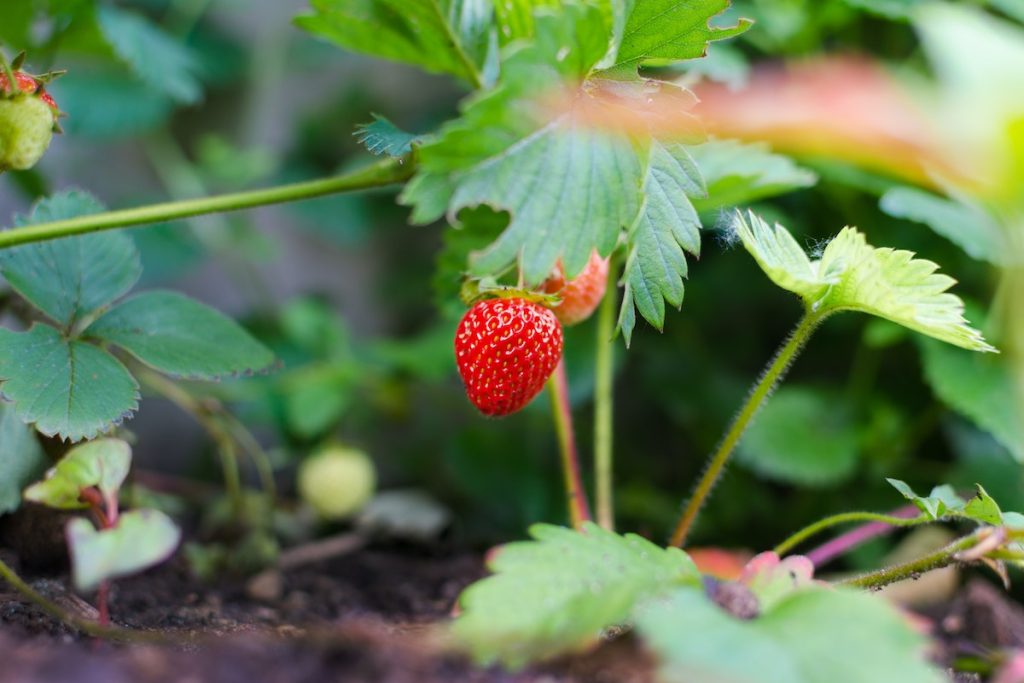Strawberries are a collection of fruits belonging to the rose family and have multiple varieties. They mostly ripen in early summer, but the growing season and harvest time depend on the type and location. Growers in some regions manage to harvest strawberries year-round, while in other regions, they are only available for a few months. Strawberries are effortless to prepare and can be consumed as they are.
Watering perennial strawberry plants is essential to maintain healthy growth and ensure optimal fruit production. The amount of water strawberry plants need depends on the time of year, the variety, and environmental conditions. This article will focus on how often you should water strawberry plants.
Watering Strawberries
Due to their delicious taste, and ease of growth in various growing conditions, strawberries are a popular choice for summer gardens. However, you must provide specific care instructions to your strawberry plants to ensure optimal growth. You must water them consistently and adjust the amount of watering based on their growth cycle. Knowing how often to water strawberry plants is essential to ensure healthy plants.
Factors to Consider When Watering Strawberries
To determine the amount and frequency of watering your strawberry plants, consider factors such as soil type, time of day, local climate, and growing season, as well as the method of watering. How you grow your strawberries, either in pots or in the ground, will also impact your watering approach.
For optimal growth, strawberries require soil that is consistently watered. Usually, they should be given about an inch of water per week, but this may need to be increased to 2.5 inches during hot and dry summer conditions.
If there is a lot of rainfall in a few days, then you should decrease the amount or number of times you water your plants. If your area receives 1 to 1.5 inches of rainfall every week, then you don’t need to water your plants. However, if there is heavy rainfall, check the soil moisture before watering to avoid drowning the roots, which can cause root rot and eventually lead to plant death.
You can test the soil using either a moisture meter or your finger. If the meter or your finger detects the soil as wet or muddy below the surface, it’s best to wait another day before watering.
Implementing Water Drainage System For Strawberries

To grow strawberries, it’s ideal to provide them with plenty of sunlight and well-draining soil that can hold moderate amounts of water. It’s best to avoid waterlogged or heavy soil as this can lead to root rot, a common issue for these plants. Raised beds or mounded rows can achieve proper drainage if constructed correctly.
If the soil pH, drainage, or type is unsuitable for strawberries, it can be improved by increasing the organic matter, constructing raised beds, adjusting the pH with amendments, and adjusting nutrient levels as necessary.
Use Raised Beds
For optimal growth, strawberries need well-drained soil. If the soil is not well-drained, the roots can die and cause root diseases. To avoid this issue, it is recommended to use raised beds. The soil’s water level must be at least 14 inches below the soil surface. Raised beds from mounded soil should be about 1 to 1.5 feet high.
During the growing season, if the soil is waterlogged for more than a few consecutive days, strawberry roots may suffocate, and the risk of root rot will rise. Although almost any soil type can be made suitable by amendment, growing plants in well-drained, fertile, loam soil with moderate water-holding capacity can result in more robust growth and increased fruit production.
Hilling Method
You can use the hilling or mounding method to create raised beds by adding soil and organic matter. Make a row of built-up material if you plan to plant several plants. An alternative is a framed raised bed with potting mix or a mixture of soil and necessary modifications. Adding organic matter helps improve soil aeration, drainage, water retention, and nutrient-holding capacity. Add organic matter to the soil before planting.
Role Of Watering In Growing Strawberries
To help strawberry plants grow well, they require frequent watering, particularly when producing fruit. During this time, they typically need about one to two inches of water daily. The most effective way to hydrate strawberries is to use a drip or soaker hose set up at least two inches from the plant. Since the roots of strawberry plants are close to the soil surface, ensure the soil remains sufficiently moist without becoming too wet. If your soil contains a lot of clay, be mindful not to water excessively.
Sprinkler Irrigation

Be careful when using sprinkler irrigation. The fruit will likely rot during the fruiting season if plants don’t dry out between watering. To avoid this, refrain from watering in the early evening. If using strawberry pots, regularly check the openings to ensure the soil doesn’t become too dry.
For best results, ensure that the soil is moist but not waterlogged. A balanced watering system will help maintain healthy strawberry plants and result in a successful harvest. Although overwatering can lead to problems like root rot, under-watering can cause foliage and fruit drop wilting. Pay attention to the amount and frequency of your watering to ensure your plants are healthy and get the nutrients they need for optimal growth.
Excess Water Usage for Strawberry Plants: Good or Bad?
Water is a low-cost input in fruit production, and producers often provide more water than needed to get a full crop. This is especially the case in the Northeast, where there is usually plenty of water, especially in the spring. However, over-irrigation or using water for frost protection can lead to nutrient loss and the growth of diseases.
A two-year study to examine the effects of four levels of supplemental irrigation showed that in one year, there were no differences in crop yield between treatments. But the other year, the two treatments that received the most supplemental irrigation had lower yields due to low nitrogen levels in the leaves. This suggests that excessive water supply can adversely affect crops, similar to water shortage.
Effects of Overwatering
One of the main problems that can affect plants is overwatering. When the soil is heavy and has poor drainage, it can become waterlogged. If this happens, the roots may not be able to absorb the oxygen they need to grow properly. As time passes, the roots can experience greater damage and eventually die. When this happens, they cannot give the plant the necessary nutrients and water.
Sometimes, people mistake damage caused by overwatering as damage caused by pests. But, roots don’t usually grow close to the soil surface because of pests. When plants are stressed or damaged due to overwatering, they can become vulnerable to certain fungal infections.
Plants can’t get enough oxygen if the soil is overly wet, leading to root death and weakened growth. Signs of overwatering include slow growth, yellowing leaves, leaf scorch or burn, and water-soaked spots on stems and leaves. Excess moisture can also cause crown rot, making plants more susceptible to rot-causing organisms and ultimately resulting in plant death.
How Often Should You Water Strawberries in Pots?
To help your strawberry plants thrive, it’s important to water them on a regular schedule. When they are growing and producing fruit, they require about one to two inches of water every week. You can jump-start newer plants by watering them with about an inch of water four times per month. You can water newer plants from above. Avoid giving them inconsistent amounts of water.
Drip Irrigation
It is recommended to moisturize your plants using a drip irrigation or a soaker hose. This helps prevent the berries from getting too wet and developing rot. Keep the irrigation system or hose at least two inches away from the growing fruits when installing it.
You can water twice weekly to keep the soil moist during the non-peak growing season. It’s recommended to water early in the day instead of the evening to prevent waterlogging. A drip irrigation system can reduce water usage by half compared to overhead watering.
Factors Affecting Watering Needs

When watering strawberry plants, it is crucial to consider several factors. Pot size, weather conditions, and soil moisture all influence the amount of water the plants need.
- Pot Size – The pot size affects how quickly the soil dries out and how frequently you need to water your strawberry plants. Generally speaking, smaller pots require more frequent watering than larger ones.
- Weather – The weather also affects how often you need to water the plants. In hot and dry conditions, strawberry plants may require more water compared to cooler months. Also, if there is a lot of rainfall in a few days, you should reduce the amount or number of times you water your plants.
- Soil Moisture – Soil moisture is also an essential factor. You can test the soil using either a moisture meter or your finger. If the meter or your finger detects the soil as wet or muddy below the surface, it’s best to wait another day before watering.
Best Time To Water Strawberry Plants
Watering is essential to growing strawberries, as healthy plants require consistent hydration to ensure optimal growth and fruit production. The amount and frequency of watering should be adjusted based on the variety, time of year, environmental conditions, and method of watering.
Low Moisture Levels
The best time for watering strawberry plants is when soil moisture levels are low. Watering in the morning, when temperatures are cooler, is preferable. You don’t need to water your plants if your area receives 1 to 1.5 inches of weekly rainfall. However, if there has been little rain in a few days and the soil is dry or compacted, water them as soon as possible.
Avoid water during the evening, leading to waterlogging and fungal diseases. Don’t water excessively, which can cause root rot and other health problems.
Watering in the Morning
It’s best to water strawberry plants in the morning when temperatures are cooler. This helps keep the soil moist and avoid root rot or other diseases. Don’t water in the evening, because it can make the soil too wet and cause problems for your plants.
During hot parts of the day, it’s better not to water because too much water can damage your plants. Excessive water can lead to fungal diseases and root rot, stunting growth or, even worse, killing plants. Watering in the morning helps keep your soil temperatures stable and allows for optimal absorption of essential nutrients and oxygen by the roots. This also prevents unnecessary losses due to evaporation or runoff. Additionally, it gives your plants enough time to dry before nightfall.
When it comes to strawberry plants, water is essential for optimal growth and fruit production. To determine the amount and frequency of watering your strawberry plants, consider factors such as soil type, time of day, local climate, and growing season, as well as the method of watering. The best time to water strawberry plants is in the morning when temperatures are cooler, as this prevents excessive water loss and helps keep the soil moist without becoming too wet. With proper care and attention, you can ensure your strawberry plants get the hydration they need to produce plenty of delicious fruit!




